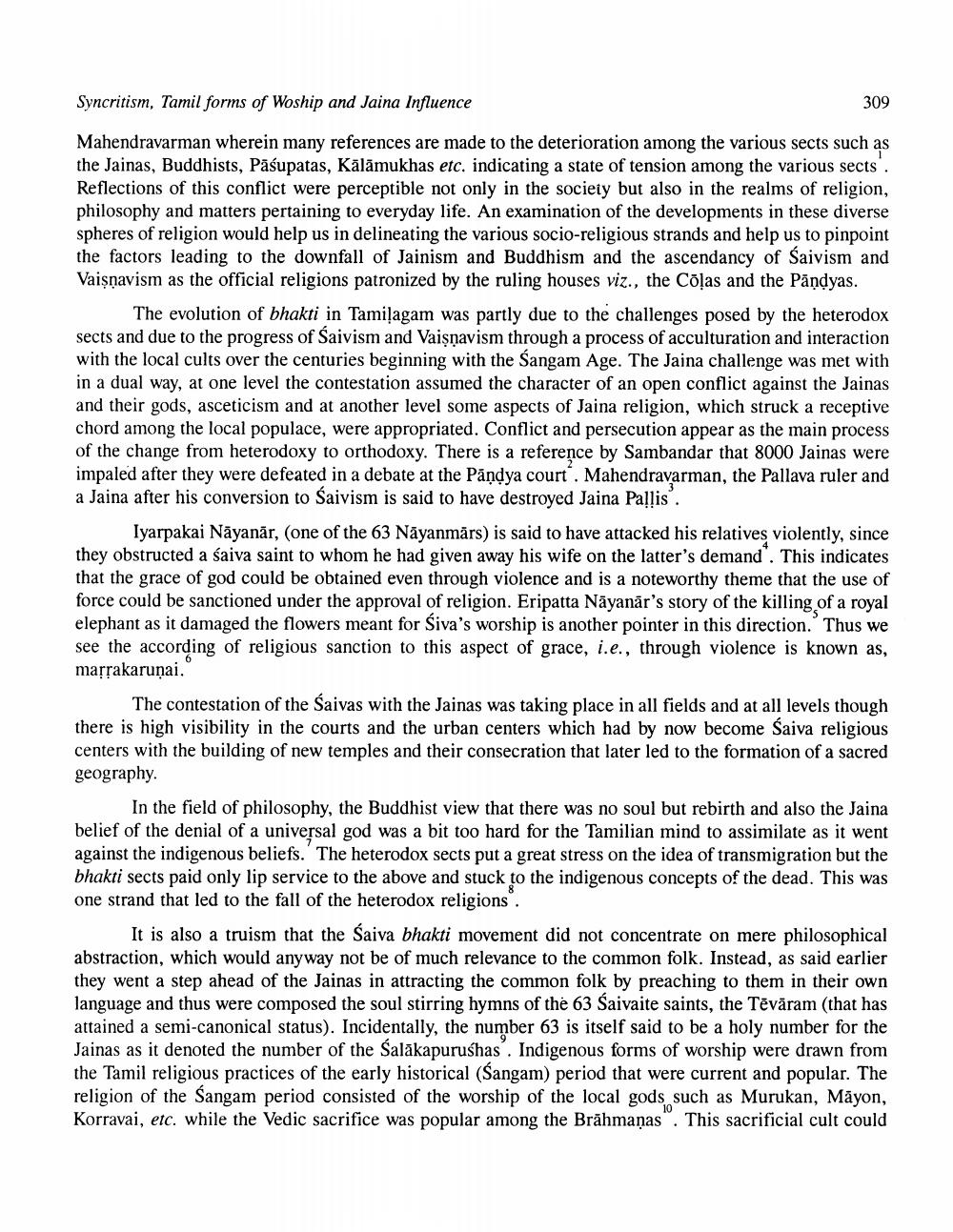________________
Syncritism, Tamil forms of Woship and Jaina Influence
309
Mahendravarman wherein many references are made to the deterioration among the various sects such as the Jainas, Buddhists, Pāśupatas, Kālāmukhas etc. indicating a state of tension among the various sects. Reflections of this conflict were perceptible not only in the socieiy but also in the realms of religion, philosophy and matters pertaining to everyday life. An examination of the developments in these diverse spheres of religion would help us in delineating the various socio-religious strands and help us to pinpoint the factors leading to the downfall of Jainism and Buddhism and the ascendancy of saivism and Vaişnavism as the official religions patronized by the ruling houses viz., the Coļas and the Pāndyas.
The evolution of bhakti in Tamilagam was partly due to the challenges posed by the heterodox sects and due to the progress of Saivism and Vaisnavism through a process of acculturation and interaction with the local cults over the centuries beginning with the Sangam Age. The Jaina challenge was met with in a dual way, at one level the contestation assumed the character of an open conflict against the Jainas and their gods, asceticism and at another level some aspects of Jaina religion, which struck a receptive chord among the local populace, were appropriated. Conflict and persecution appear as the main process of the change from heterodoxy to orthodoxy. There is a reference by Sambandar that 8000 Jainas were impaled after they were defeated in a debate at the Pāņdya court. Mahendravarman, the Pallava ruler and a Jaina after his conversion to Saivism is said to have destroyed Jaina Pallis.
Iyarpakai Nāyanār, (one of the 63 Nāyanmārs) is said to have attacked his relatives violently, since they obstructed a saiva saint to whom he had given away his wife on the latter's demand". This indicates that the grace of god could be obtained even through violence and is a noteworthy theme that the use of force could be sanctioned under the approval of religion. Eripatta Nāyanār's story of the killing of a royal elephant as it damaged the flowers meant for Siva's worship is another pointer in this direction. Thus we see the according of religious sanction to this aspect of grace, i.e., through violence is known as, marsakaruņai.
The contestation of the Saivas with the Jainas was taking place in all fields and at all levels though there is high visibility in the courts and the urban centers which had by now become Saiva religious centers with the building of new temples and their consecration that later led to the formation of a sacred geography
In the field of philosophy, the Buddhist view that there was no soul but rebirth and also the Jaina belief of the denial of a universal god was a bit too hard for the Tamilian mind to assimilate as it went against the indigenous beliefs. The heterodox sects put a great stress on the idea of transmigration but the bhakti sects paid only lip service to the above and stuck to the indigenous concepts of the dead. This was one strand that led to the fall of the heterodox religions.
It is also a truism that the Saiva bhakti movement did not concentrate on mere philosophical abstraction, which would anyway not be of much relevance to the common folk. Instead, as said earlier they went a step ahead of the Jainas in attracting the common folk by preaching to them in their own language and thus were composed the soul stirring hymns of the 63 Saivaite saints, the Tēvāram (that has attained a semi-canonical status). Incidentally, the number 63 is itself said to be a holy number for the Jainas as it denoted the number of the Salākapurushas'. Indigenous forms of worship were drawn from the Tamil religious practices of the early historical (Sangam) period that were current and popular. The religion of the Sangam period consisted of the worship of the local gods such as Murukan, Māyon, Korravai, etc. while the Vedic sacrifice was popular among the Brāhmaṇas. This sacrificial cult could




